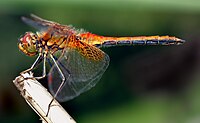
Photo from wikipedia
Colonizing organisms actively choosing habitats face a bewildering array of choices regarding patch quality, whether choosing for themselves, offspring, or both. Decisions are especially critical when selecting patches for long-term… Click to show full abstract
Colonizing organisms actively choosing habitats face a bewildering array of choices regarding patch quality, whether choosing for themselves, offspring, or both. Decisions are especially critical when selecting patches for long-term use (demographic habitat selection). Thus, identifying higher quality patches based on available cues, and integrating information across multiple axes of patch quality, is critical to survival, performance, and fitness. Two critical axes of patch quality for ovipositing gray treefrogs, revealed by prior experiments, are predation risk and patch size. We utilized a unique design presenting two, suboptimal patch choices: small fishless pools and large pools with fish. Our goal was to gain an understanding of the relative priority of these two important patch characteristics for treefrogs by presenting only compromise choices and comparing these results to expectations generated by a previous experiment. In the absence of optimal patches, treefrogs increased their use of both large pools with fish and especially small fishless patches, both of which are unused when larger fishless patches are available. These results reaffirm the primacy of predation, especially the presence of fish, vividly illustrating the spatial context dependence of habitat selection behavior, as well as the complexity of the decisions faced by colonizing and ovipositing organisms in complex landscapes.
Journal Title: Ecosphere
Year Published: 2021
Link to full text (if available)
Share on Social Media: Sign Up to like & get
recommendations!